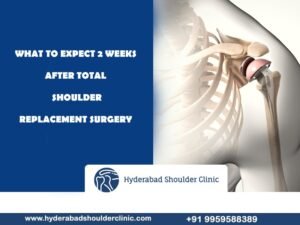A broken shoulder is another word for a shoulder fracture. The shoulder is an intricate connection joint that connects the arm to the body. It has many different parts, including the humerus (upper arm bone), shoulder blade (shoulder bone) and the clavicle (collar bone). The top end of the humerus has a round-shaped ball-like structure, which gets connected to the shoulder blades, called glenoid, and forms “ball and socket joint”.
Trauma can cause humerus (ball) or glenoid (socket) fractures of the shoulder joint. Most of these injuries can be treated without surgery with excellent results and long-lasting. Some fractures are easier to operate because they can pose a high risk of arthritis if left alone. Some cannot be cured.
Fractures described as displaced or non displaced. Fortunately, most of the shoulder fractures are non displaced. It means that the fragments remain close to their anatomical position and treatment only requires immobilization in the sling until the bone fragments have healed. Most shoulder fractures heal after about six weeks. About 20 percent of shoulder fractures are removed and may need to be manipulated to restore normal anatomy.
Sometimes the rotator cuff muscles are injured or torn at the same time as the fracture. It can make treatment more difficult.
In general, the type of shoulder fracture depends on the age of the person. Children are more likely to break their collarbones, while elders are more likely to break their shoulders.
If you have injured your shoulder, see an orthopaedic surgeon or hand specialist as soon as possible because so many shoulder surgeons can heal. Shoulder. X-ray or computed tomography is the only way to ensure that you have a fracture. The longer you delay the treatment, the higher the risk of permanent damage.
A surgeon treats a fracture with or without surgery, depending on the symptoms, age, and location of the fracture. You only need to meet the doctor for three to eight weeks. If surgery is necessary, you need to take time to recover. Your surgeon will give you more information about when you can move your shoulders, exercise, and contact sports again. You may also need physical therapy after surgery to avoid permanent shoulder stiffness.
Active patients and the elderly are most at risk of shoulder fractures. Shoulder fractures are caused due to trauma, usually the fall of an outstretched arm or direct impact on the shoulder, such as in a traffic accident, and by contact sports.
This article provided by Dr Chandrasekhar B. gives the information about the most common shoulder fractures.
Before that, let us see!
Anatomy Of The Shoulder:

The shoulder consists of three bones: shoulder blade, clavicle bone (collarbone) and humerus bone; In addition, there are soft tissues such as muscles, tendons, ligaments and joint capsules that hold joint bones together. A rotator cuff is a group of tendons that stretch around the shoulder joint and should keep the upper arm bone in the shoulder socket.
What is A Shoulder Fracture:

A fractured shoulder is usually a damaged humerus. A broken bone is medically called a fracture. If your shoulder gets broken near the shoulder joint, it is generally called a broken shoulder. The humerus can break in many places, and fractures are usually described by location.
Types of Shoulder Fractures:

The shoulder are joints that have the most excellent range of motion of all joints in the body. It consists of three bones: the clavicle or scapula and proximal humerus, which is the uppermost part of the arm bone. These bones cross and form two joints in the shoulder. Fractures can occur in all joints.
Muscles, tendons and ligaments surround and stabilize joints and prevent bone movements. They can also get hurt if breaks occur.
Clavicle Fracture:

The collarbone, also called the clavicle, is a long bone that connects the shoulder blade or breastbone. The collarbone fracture is the most common type of shoulder fracture.
Symptoms include acute pain at the site of injury, swelling, and bruising. You may have difficulty moving your arms, and this movement can cause a painful grinding sensation when the broken ends of the bone rub against each other.
A broken clavicle can also cause the shoulder to contract, and a bump appears under the skin where the bone gets broken. If the fracture is caused by a severe injury, such as a car accident, the bone can penetrate the skin, called an open fracture.
Scapula Fracture:

The shoulder blade or is a large, flat, triangular bone on your back that connects the humerus with the clavicle or collarbone. The blade is well protected from the surrounding muscles and does not easily break, but an energetic, direct impact – which could be the result of a car or motorcycle accident – can break bones in two or more parts.
Symptoms include severe and sharp shoulder pain when trying to move the arm, swelling, bruising, and skin sensitivity to injury. Scapular fractures are rarely open fractures, and surgery may not be needed to cure them.
Proximal Humerus Fracture:

The proximal humerus is a rounded upper part that rotates within the shoulder socket joint. This bone can be broken due to falls or car accidents, or as a result of shoulder displacement, which pushes spit out of the socket.
Symptoms include severe pain, limited shoulder movements, swelling, tenderness, and cracking, called crepitus when trying to move the arm.
People with osteoporosis have this type of shoulder fracture more commonly. This condition causes bones to become weak and brittle and the risk of all kinds of fractures increases. Osteoporosis affects more women than men and twice as many women as men suffer from proximal fractures each year, mostly due to falls.
Treatment for Shoulder Fractures:

Medical:
Most non displaced fractures require fixation of the sling while the fracture heals sufficiently to feel comfortable and allow movement without risk of dislodging the fracture. X-rays are used to determine whether sufficient healing has occurred to allow movement.
It is essential to maintain the mobility of the elbows, wrists and fingers when resting your shoulders. Under the guidance of your doctor, you can start moving the shoulder until the fracture is healed. Moving the arm too early can delay healing, but too little movement causes stiffness.
Treatments for Shoulder Fractures:

Conservative treatment is sometimes used to treat shoulder fractures regardless of severity. This treatment includes:
- Immobilization to unite the bone fragments and hold them in the correct anatomical position. Your doctor usually recommends a sling, splint, or cast for 2 to 4 weeks. Immobilizer can be recommended for longer, depending on the location and severity of the rest.
- Physiotherapy helps restore arm movement and strength. Physical therapy usually starts 2 to 3 weeks after the injury.
- Nonsteroidal anti-inflammatory drugs (NSAIDs) prescribed to relieve mild to moderate pain.
Many shoulder fractures heal after about four months without surgical treatment. However, some shoulder fractures need to be operated on to improve correctly. Minimally invasive shoulder fracture repair and shoulder replacement surgery are practical options for treating severe fractures and many possible complications.
Conclusion:
Treatment of shoulder fractures varies greatly and ranges from simple immobilization to complex surgical interventions. It would help if you discussed treatment options with a surgeon who can give you advice about the advantages and disadvantages of various treatments.
Make an appointment with Dr Chandrasekhar.B Shoulder surgeon, if you are worried about a shoulder fracture. Dr Chandrasekhar.B is a certified orthopedist with expertise in shoulder reconstruction and replacement.
Visit Dr Chandrasekhar.B website for more information and or for appointments or contact us at 9959588389.
.
Doctors use all available testing and surgical procedures to give our patients safe, effective care and physical therapy that helps patients regain strength and mobility. Doctor tailors the treatment as per the needs of each patient. Dr Chandrasekhar.B shoulder surgeon will work with each patient to ensure the right treatment plan. If surgery is needed, he is eligible for minimally invasive fracture repair and shoulder replacement surgery if the bone cannot get repaired.





